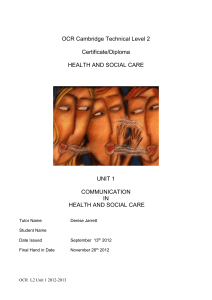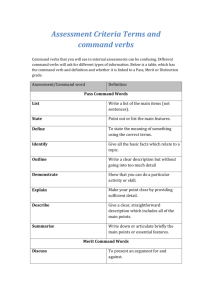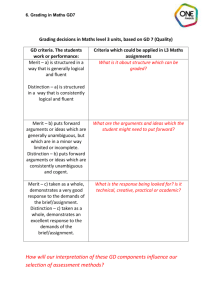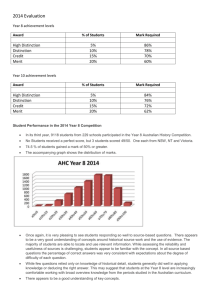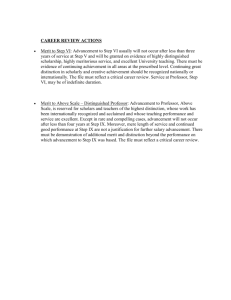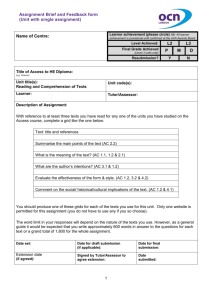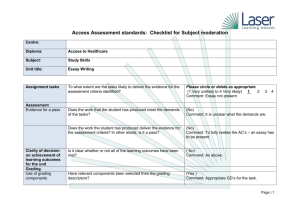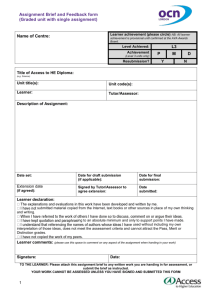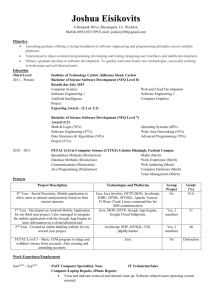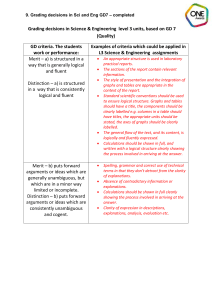Assignment unit 10 Health and care services
advertisement
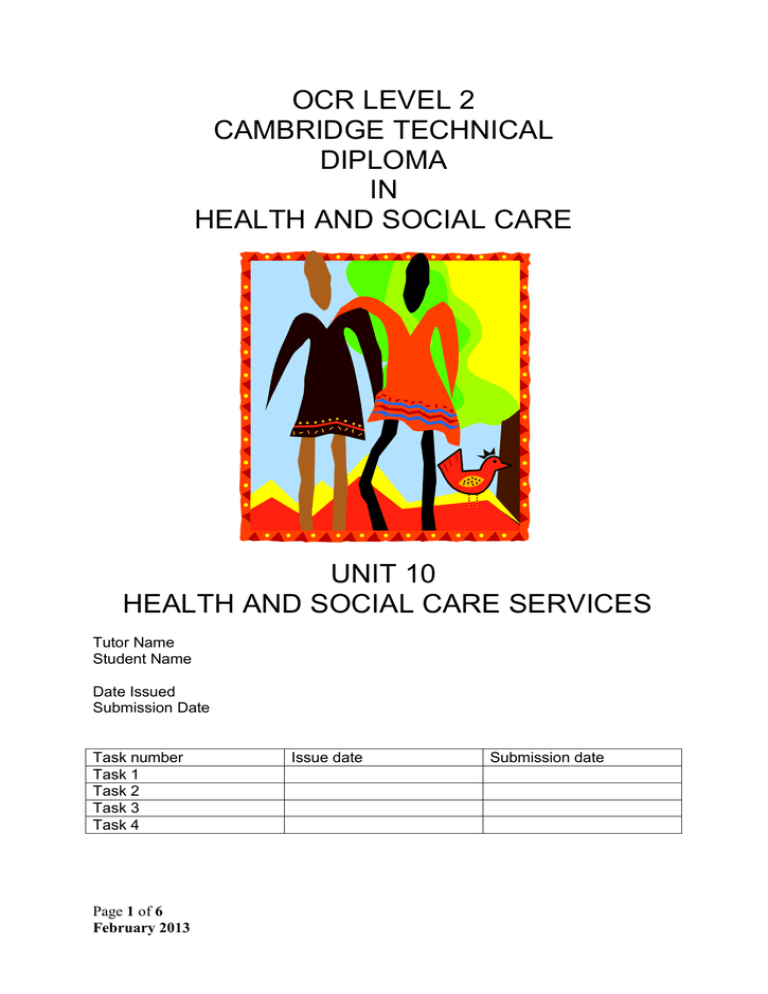
OCR LEVEL 2 CAMBRIDGE TECHNICAL DIPLOMA IN HEALTH AND SOCIAL CARE UNIT 10 HEALTH AND SOCIAL CARE SERVICES Tutor Name Student Name Date Issued Submission Date Task number Task 1 Task 2 Task 3 Task 4 Page 1 of 6 February 2013 Issue date Submission date This unit introduces you to the different types of service provision within Health and Social Care. The unit considers how central government policies impact on Health and Social Care provision. The unit aims to provide an overview of types of services, barriers which could affect access to services and differing job roles which exist within these services. ………………………………………….. This assignment is split into a number of tasks. In each task there is a chance to work towards the pass criteria for this unit; you must complete all pass tasks to achieve a pass for this unit. Activities completed independently in class may contribute towards a pass mark. In each task there is the opportunity to complete additional work to achieve a Merit or Distinction for this unit. Merit and Distinction tasks require a greater depth of understanding with clear evidence of independent learning and research. These tasks expect you to be able to relate your answers to a practical setting. REMEMBER: You must complete all the pass tasks before starting on Merit or Distinction. Each task asks you to complete various activities and gives you suggestions on how to set out and complete your work. Each task will clearly show whether it is a Pass, Merit or Distinction. P is for Pass M is for Merit D is for Distinction You may like to discuss with your tutor which level of activities you would like to work towards. When you hand in your work please remember to Put your name on all your sheets Put your work in a plastic folder Make a front cover for your assignment to include your name and the unit Make sure the assignment booklet is included with your work as well Indicate any resource material you have used e.g. books, internet sites for any research you have undertaken Hand it in on time. Work submitted after the set date may not be marked Page 2 of 6 February 2013 Do not copy straight from tutor prepared notes, handouts or directly from the internet. You will not get any marks for this. Do not copy from another students work. This includes work from the internet. This is known as plagiarism and is a very serious offence. Please read the course handbook alongside these notes Learning Outcome Pass Merit Distinction The assessment criteria for this unit are the pass criteria To achieve a merit the evidence must show that in addition to the pass criteria the learner is able to To achieve a distinction the evidence must show that in addition to the pass and merit criteria the learner is able to The learner will: The learner can: 1. Know key elements of health & social care services P1 Identify the key elements of health & social care services M1 describe government policy that affects health or social care services Know barriers to accessing health & social care services P2 Identify the main barriers to accessing health & social care services M2 Describe possible effects of barriers on people who use services 2. 3. Understand principles of partnership in health or social care 4. Understand requirements for job roles in health and social care. Page 3 of 6 February 2013 P3 Explain the benefits of interagency partnerships P4 Explain the skills required for two different job roles in health and social care D1 Review a case where effective partnership working could have, or did, affect the outcome for a person who uses health or social care services D2 Evaluate qualification pathways available for job roles in health or social care Level 1 Functional skill standards Functional Skills are practical skills in English, Information and Communication Technology (ICT) and Mathematics that allow individuals to work confidently, effectively and independently in life. During this unit you will have an opportunity to practice the English functional skill Skill standards Speaking, listening and communication 1. Take full part in formal and informal discussions and exchanges that include unfamiliar subjects. Reading 2. Read and understand a range of straightforward texts. Coverage and range a) Make relevant and extended contributions to discussions, allowing for the responding to others’ input; (E.L1.1a) b) Prepare for and contribute to the formal discussion of ideas and opinions; (E.L1.1b) c) Make different kinds of contributions to discussions; (E.L1.1c) d) Present information/points of view clearly and in appropriate language. (E.L1.1d) a) Identify the main points and ideas and how they are presented in a variety of texts ;(E.L1.2a) b) Read and understand texts in detail; (E.L1.2b) c) Utilise information contained in texts; (E.L1.2c) d) Identify suitable responses to texts; (E.L1.2d) e) In more than one type of text.(E.L1.2e) Writing 3. Write a range of texts to communicate information, ideas and opinions, using formats and styles suitable for their purpose and audience. a) Write clearly and coherently, including an appropriate level of detail;(E.L1.3a) b) Present information in a logical sequence;(E.L1.3b) c) Use language, format and structure suitable for purpose and audience; (E.L1.3c) d) Use correct grammar, including correct and consistent use of tense;(E.L1.3d) e) Ensure written work includes generally accurate punctuation and spelling that meaning is clear;(E.L1.3e) f) In more than one type of text.(E.L1.3f ) Page 4 of 6 February 2013 Task 1 P1 Identify the key elements of health and social care services You need to write about what the four types of service provision; statutory, voluntary, private and informal. HINT: The work could be presented as a table showing a list of health and social care settings under each heading. You could also identify settings from your local area. M1 Describe government policy that affects health or social care services You will need to choose one of the following policies and produce a description of how it has affected a Health and Social Care setting. You can present your work as a poster, a power point presentation or a piece of written work but make sure that you describe the policy in detail. • Every Child Matters • The Equality Act • Current NHS reforms • Surestart • Children Act • NHS and Care in the Community Act Task 2 P2 Identify the main barriers to accessing health and social care services You need to prepare an information booklet identifying barriers to access and include examples of the barriers. HINT: if you want to work towards the Merit, please read the task M2 before you begin work on your booklet. M2 Describe possible effects of barriers on people who use services Using PIES, describe possible effects of barriers to access. This can be included in your booklet either alongside some of the barriers that you have identified or at the end of your booklet where holistic effects can be explained. Page 5 of 6 February 2013 Task 3 P3 Explain the benefits of interagency partnerships You will need to prepare a piece of writing that details why partnership working could benefit service users. D1 Review a case where effective partnership working could have, or did, affect the outcome for a person who uses health or social care services This is a more detailed piece of writing that discusses how organisations working together could benefit your chosen individual. Remember that you can discuss positive or negative points. HINT: You can look at a real person that you know for example, the person that you discussed in Unit 3 (individual needs) or a case that has been in the media such as Baby P. If you choose a real case, you will need to fully research it. Task 4 P4 Explain the skills required for 2 different job roles in health & social care You need to describe the skills and qualities required for two jobs. You could prepare two job specification sheets, one for each job that could be sent out to prospective employees. D2 Evaluate qualification pathways available for job roles in health or social care This piece of work consists of two parts; a) Using the job roles that you identified in P4, you could prepare two diagrams or flowcharts showing qualification/training pathways. b) You will then continue and prepare a piece of writing outlining the advantages and disadvantages of the different types of pathway. Page 6 of 6 February 2013
